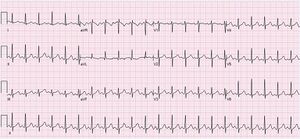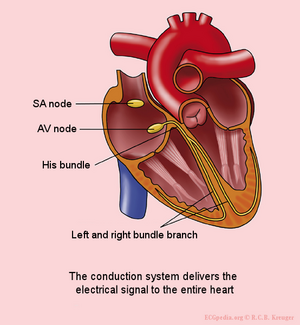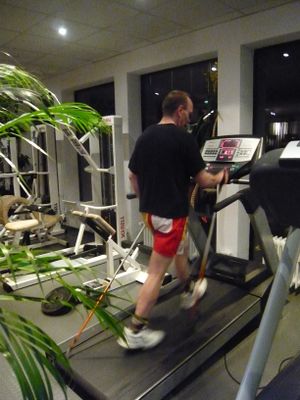Tachycardia: Difference between revisions
No edit summary |
No edit summary |
||
| (6 intermediate revisions by one other user not shown) | |||
| Line 5: | Line 5: | ||
</div> | </div> | ||
== Introduction == | == Introduction == | ||
Sinus tachycardia is a regular cardiac rhythm in which the heart beats faster than normal. While it is common to have tachycardia as a physiological response to exercise or stress, it causes concern when it occurs at rest | [[File:Achycardia 132 bpm.jpeg|thumb|ECG showing sinus tachycardia, 132 bpm]] | ||
Sinus tachycardia is a regular [[Heart Arrhythmias|cardiac rhythm]] in which the [[Muscle: Cardiac|heart]] beats faster than normal. While it is common to have tachycardia as a physiological response to exercise or stress, it causes concern when it occurs at rest. | |||
The normal resting heart rate for adults is between 60 and 100, which varies based on the level of fitness or the presence of medical [[Multimorbidity|comorbidities]]. Sometimes tachycardia signifies a health problem and could be the earliest sign of serious pathology. Thus, it is crucial to rapidly identify the underlying cause of tachycardia and determine if it indicates urgent evaluation and/or treatment. <ref>Henning A, Krawiec C. [https://www.ncbi.nlm.nih.gov/books/NBK553128/ Sinus tachycardia]. InStatPearls [Internet] 2021 Aug 11. StatPearls Publishing.Available: https://www.ncbi.nlm.nih.gov/books/NBK553128/<nowiki/>(accessed 30.2.2022)</ref><ref name=":0">Health direct Tachycardia Available:https://www.healthdirect.gov.au/tachycardia (accessed 30.3.2022)</ref>. | |||
In some cases, tachycardia may cause no symptoms or complications. However if left untreated, tachycardia can disrupt normal heart function and lead to serious complications, including: | |||
= | * [[Heart Failure|Heart failure]] | ||
* [[Stroke]] | |||
* Sudden [[Cardiac Arrest|cardiac arrest]] or death<ref name=":1">Bloom Tachycardia and exercise Available: https://bloomalliedhealth.com/tachycardia-and-exercise/<nowiki/>(accessed 30.3.2022)</ref>. | |||
{{#ev:youtube|uvnDpZUNOJI}} | |||
== | == Signs and Symptoms == | ||
[[File:Heart rate.jpeg|thumb|[[Heart Rate|Heart rate]] check]] | |||
Tachycardia may cause no symptoms or complications. Signs and symptoms that may present include | |||
or | |||
# | * [[Dyspnoea|Shortness of breath]] and lightheadedness. | ||
# | * Chest pain. | ||
* A rapid, irregular [[Pulse rate|pulse]] felt on the wrist or side of the neck. | |||
* Uncomfortable and rapid heart palpitations felt in the chest. | |||
== Etiologies == | |||
Tachycardia can have physiological or pathological causes. Physiologically it is commonly associated with catecholaminergic triggers ,eg [[Therapeutic Exercise|exercise]], stress, [[Pain Behaviours|pain]], and anxiety. Pathologically, there are cardiac and non-cardiac etiologies, see below | |||
== Cardiac Etiologies == | |||
[[File:Conduction system.png|right|frameless]] | |||
Include: | |||
* Supraventricular (above the [[Left Ventricle Heart|ventricle]]): where problems with the electrical signals in the atria of the heart cause the heart to beat faster, reducing blood flow to the rest of the body as the heart can't pump blood as effectively. eg atrial flutter and [[Atrial Fibrillation|atrial fibrillation]]. | |||
* Ventricular tachycardia: where the electrical signals in the ventricles of the heart cause the heart to beat faster affecting its ability to pump [[blood]] to the rest of the body. | |||
* [[Acute Coronary Syndrome|Acute coronary syndrome]] | |||
* Torsades de pointes | |||
* Myocarditis is an inflammatory process involving cardiac myocytes that is generally secondary to a viral infection. | |||
* Cardiac tamponade is a collection of symptoms (traditionally hypotension, jugular venous distention, muffled heart sounds, pulses paradoxus, and interventricular septum bowing during inspiration) secondary to increased pressure in the pericardial space | |||
== Other Etiologies == | |||
Include: | |||
# Respiratory: [[Pulmonary Embolism|Pulmonary Emboli]]; Hypoxia. | |||
# Gastrointestinal/Renal/Electrolyte: [[Hypoglycemia]]; [[Dehydration]]; [[Hyperkalemia]]; [[Hypomagnesemia]]. | |||
# [[Infectious Disease]]: [[Sepsis]] is a systemic inflammatory illness secondary to an infection that causes organ dysfunction | |||
# Vascular: [[Shock]] is an acute circulatory failure that provides insufficient tissue perfusion and hypoxia. | |||
# Hematologic: Hemorrhage is the disease process where a clinically significant amount of blood is lost after a blood vessel is damaged; [[Anemia]] | |||
# Toxicology: Ingestion of medications can cause tachycardia; Withdrawal from [[Substance Use Disorder|substances]] or medications is an additional source of tachycardia. | |||
# Sinus tachycardia; where the natural pacemaker in the heart sends electrical signals faster than normal. This can be in response to a [[Stress and Health|stress]]<nowiki/>or, or it can be a sign of eg [[anaemia]], problems with the [[Thyroid Gland|thyroid gland]] or general ill health<ref name=":0" />. | |||
== Physiotherapy == | |||
[[File:Treadmill walk.jpg|thumb|Treadmill walk]] | |||
[[Therapeutic Exercise|Exercise]] is an important part of a healthy lifestyle, and it should not be avoided, even in clients who have a heart condition. For the vast majority of people with arrhythmias eg atrial fibrillation and tachycardia, exercise is encouraged. Exercise helps to strengthen the [[Cardiovascular System|cardiovascular system]] and has a protective function against tachycardias | |||
* Before starting exercise [[Cardiopulmonary Exercise Testing (CPET) In Adults|Cardiopulmonary Exercise Testing]] may be appropriate. | |||
* Once client is cleaared by Cardiologist to commence exercise, stress importance of a slow start and and build up over time. If you client feels symptoms eg dizziness, palpitations or chest pain it is important to seek medical assistance immediately. | |||
* Over time, client will understand how their body responds to certain exercise modalities and intensities, and you can adjust your exercise accordingly<ref name=":1" />. | |||
* Enrolling client into [[Cardiac Rehabilitation]] is a great option. | |||
* See also [[Physical Activity and Cardiovascular Disease]] and [[Physical Activity and Exercise Prescription]] | |||
== References == | == References == | ||
<references /> | <references /> | ||
Latest revision as of 12:06, 30 March 2022
Original Editor - Lucinda hampton
Top Contributors - Lucinda hampton and Tolulope Adeniji
Introduction[edit | edit source]
Sinus tachycardia is a regular cardiac rhythm in which the heart beats faster than normal. While it is common to have tachycardia as a physiological response to exercise or stress, it causes concern when it occurs at rest.
The normal resting heart rate for adults is between 60 and 100, which varies based on the level of fitness or the presence of medical comorbidities. Sometimes tachycardia signifies a health problem and could be the earliest sign of serious pathology. Thus, it is crucial to rapidly identify the underlying cause of tachycardia and determine if it indicates urgent evaluation and/or treatment. [1][2].
In some cases, tachycardia may cause no symptoms or complications. However if left untreated, tachycardia can disrupt normal heart function and lead to serious complications, including:
- Heart failure
- Stroke
- Sudden cardiac arrest or death[3].
Signs and Symptoms[edit | edit source]

Tachycardia may cause no symptoms or complications. Signs and symptoms that may present include
- Shortness of breath and lightheadedness.
- Chest pain.
- A rapid, irregular pulse felt on the wrist or side of the neck.
- Uncomfortable and rapid heart palpitations felt in the chest.
Etiologies[edit | edit source]
Tachycardia can have physiological or pathological causes. Physiologically it is commonly associated with catecholaminergic triggers ,eg exercise, stress, pain, and anxiety. Pathologically, there are cardiac and non-cardiac etiologies, see below
Cardiac Etiologies[edit | edit source]
Include:
- Supraventricular (above the ventricle): where problems with the electrical signals in the atria of the heart cause the heart to beat faster, reducing blood flow to the rest of the body as the heart can't pump blood as effectively. eg atrial flutter and atrial fibrillation.
- Ventricular tachycardia: where the electrical signals in the ventricles of the heart cause the heart to beat faster affecting its ability to pump blood to the rest of the body.
- Acute coronary syndrome
- Torsades de pointes
- Myocarditis is an inflammatory process involving cardiac myocytes that is generally secondary to a viral infection.
- Cardiac tamponade is a collection of symptoms (traditionally hypotension, jugular venous distention, muffled heart sounds, pulses paradoxus, and interventricular septum bowing during inspiration) secondary to increased pressure in the pericardial space
Other Etiologies[edit | edit source]
Include:
- Respiratory: Pulmonary Emboli; Hypoxia.
- Gastrointestinal/Renal/Electrolyte: Hypoglycemia; Dehydration; Hyperkalemia; Hypomagnesemia.
- Infectious Disease: Sepsis is a systemic inflammatory illness secondary to an infection that causes organ dysfunction
- Vascular: Shock is an acute circulatory failure that provides insufficient tissue perfusion and hypoxia.
- Hematologic: Hemorrhage is the disease process where a clinically significant amount of blood is lost after a blood vessel is damaged; Anemia
- Toxicology: Ingestion of medications can cause tachycardia; Withdrawal from substances or medications is an additional source of tachycardia.
- Sinus tachycardia; where the natural pacemaker in the heart sends electrical signals faster than normal. This can be in response to a stressor, or it can be a sign of eg anaemia, problems with the thyroid gland or general ill health[2].
Physiotherapy[edit | edit source]
Exercise is an important part of a healthy lifestyle, and it should not be avoided, even in clients who have a heart condition. For the vast majority of people with arrhythmias eg atrial fibrillation and tachycardia, exercise is encouraged. Exercise helps to strengthen the cardiovascular system and has a protective function against tachycardias
- Before starting exercise Cardiopulmonary Exercise Testing may be appropriate.
- Once client is cleaared by Cardiologist to commence exercise, stress importance of a slow start and and build up over time. If you client feels symptoms eg dizziness, palpitations or chest pain it is important to seek medical assistance immediately.
- Over time, client will understand how their body responds to certain exercise modalities and intensities, and you can adjust your exercise accordingly[3].
- Enrolling client into Cardiac Rehabilitation is a great option.
- See also Physical Activity and Cardiovascular Disease and Physical Activity and Exercise Prescription
References[edit | edit source]
- ↑ Henning A, Krawiec C. Sinus tachycardia. InStatPearls [Internet] 2021 Aug 11. StatPearls Publishing.Available: https://www.ncbi.nlm.nih.gov/books/NBK553128/(accessed 30.2.2022)
- ↑ 2.0 2.1 Health direct Tachycardia Available:https://www.healthdirect.gov.au/tachycardia (accessed 30.3.2022)
- ↑ 3.0 3.1 Bloom Tachycardia and exercise Available: https://bloomalliedhealth.com/tachycardia-and-exercise/(accessed 30.3.2022)









